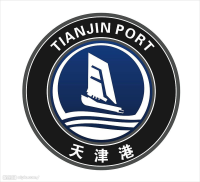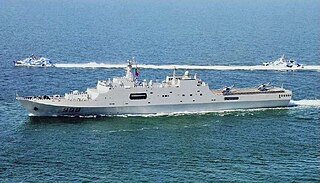The Type 072III landing ship is the follow-on of the Type 072II landing ships initially introduced in the 1990s by the People's Republic of China. Type 072-III features a redesigned concealed bridge, and possibly enhanced sealift capability. The main difference between Type 072III and its predecessor Type 072II is that Type 072III incorporates a helicopter platform at stern. A total of eleven ships have entered service with People's Liberation Army Navy (PLAN), and all of them were built by China Shipbuilding Shipyard (中华造船厂) in Shanghai. 6 Type 072III are deployed in PLAN South Sea Fleet (SSF), and the remaining are deployed in PLAN East Sea Fleet (ESF).

The Port of Tianjin, formerly known as the Port of Tanggu, is the largest port in Northern China and the main maritime gateway to Beijing. The name "Tianjin Xingang", which strictly speaking refers only to the main seaport area, is sometimes used to refer to the whole port. The port is on the western shore of the Bohai Bay, centred on the estuary of the Haihe River, 170 km southeast of Beijing and 60 km east of Tianjin city. It is the largest man-made port in mainland China, and one of the largest in the world. It covers 121 square kilometers of land surface, with over 31.9 km of quay shoreline and 151 production berths at the end of 2010.

Kunlun Shan is the lead ship of China's Type 071 amphibious transport dock Yuzhao class. The ship was laid down in the Hudong-Zhonghua Shipbuilding in Shanghai in June 2006 and was launched on 21 December 2006. After finishing trials the ship was commissioned to the South Sea Fleet on 30 November 2007, at Zhanjiang Naval Base. Its estimated production cost is USD300 million.
Beidiao 993 is an experimental ship chartered by the Chinese People's Liberation Army Navy (PLAN), and operated by the 760th Research Institute of China Shipbuilding Industry Corporation (CSIC), receiving NATO reporting name Kantan勘探 in Chinese, meaning Exploration.
Type 922 rescue and salvage ship is a series of rescue and salvage ships developed by China for the People's Liberation Army Navy (PLAN), and after decades of service they still remain active in other Chinese governmental establishments.
Type 906 torpedo trial craft is a Chinese torpedo craft currently in service with the People's Liberation Army Navy (PLAN), and has received NATO reporting name Xiang Yang Hong 9 or 向阳红 9, meaning facing the red sun. After more than three decades of service, the ship still remains active as of mid 2010s. In addition to support torpedo weaponry development, the ship is equipped to perform various research tasks, and thus also classified as general purpose research ship (AGE/AG).
Type 635 hydrographic survey ship is a series of hydrographic survey ships developed by China for its People's Liberation Army Navy (PLAN). More successful than Type 625 of the same era, Type 635 still remains active in PLAN after half a century of service, even after its successor Type 636 has entered service. Type 635 series in PLAN service are designated by a combination of two Chinese characters followed by three-digit number. The second Chinese character is Ce (测), meaning survey in Chinese, because these ships are classified as survey ship. The first Chinese character denotes which fleet the ship is service with, with East for East Sea Fleet, North for North Sea Fleet, and South for South Sea Fleet. However, pennant numbers may have changed due to the change of Chinese naval ships naming convention.
Type 639 is a type of ocean surveillance ship is a type of oceanographic surveillance ship developed by China for its People's Liberation Army Navy (PLAN) to replace earlier Type 595. A single unit of Type 639 with pennant number Bei-diao 992 is currently in service as an oceanographic research ship and five more modified version serving as hydrographic survey ships are designated as Type 639A. Type 639 has received NATO reporting name Kanhai class, 勘海 in Chinese, meaning Surveying Sea.
Chinese oceanographic research ship Zhang Jian is a Chinese research ship designed by Shanghai Ocean University and built by the civilian owned Zhejiang TianShi Shipbuilding Co., Ltd. (浙江天时造船有限公司) in Wenling, instead of government-owned enterprise, as in most cases of the ships in Chinese service.
The Duhast class tug is a little known class of naval auxiliary currently in service with the People's Liberation Army Navy (PLAN), and this 3200-horsepower tug has received NATO reporting name Duhast class. Built by Wuhu Xinlian Shipbuilding Co., Ltd. (芜湖新联造船有限公司), formerly Wuhu Shipyard, since 2004, the name of this class is taken from the installed power of the vessels, with the exact type designation still remaining unknown. After the first pair was built, as of the mid-2010s, a total of twelve of this class have been confirmed as being in active service.
The Type 02 torpedo boat is a family of Chinese torpedo boats developed from the Soviet P 6-class torpedo boat, and these boats have since retired from active service in the People's Liberation Army Navy (PLAN).
Type 7102 is a Chinese minesweeper developed for the People's Liberation Army Navy (PLAN), and by the early 2010s, it has already been retired from active service from PLAN.
The Type 032 midget submarine and its experimental version Type 032-1 belongs to a family of midget sub developed by the People's Liberation Army Navy (PLAN) in the late 1950s, and it was one of the first submarine indigenously developed in the People's Republic of China (PRC). However, due to the political turmoil in China at the time, Type 032 series was cancelled after only a single unit was completed.
Type 528 reconnaissance boat is a type of reconnaissance boat developed by China for the People's Liberation Army Navy (PLAN).
Type 0105 gunboat was a type of gunboat developed by China for the People's Liberation Army Navy (PLAN) in the late 1950s.
Type 52 gunboat was a type of gunboat developed by China for the People's Liberation Army Navy (PLAN) in the early 1950s, and it was the first indigenously developed gunboat in the People's Republic of China (PRC) that entered mass production
Type 0109 gunboat was a type of gunboat developed by China for the People's Liberation Army Navy (PLAN) in the late 1950s, and has since retired.

Wuhu Rail Transit is a two-line monorail rapid transit system in Wuhu, Anhui, China. Both lines use Bombardier Innovia Monorail 300 trains manufactured under a joint venture with CRRC. Line 1 opened on 3 November 2021, with Line 2 opening on 28 December 2021.
Type 80 demolition boat is a type of little known obstacle clearance boat built in the People’s Republic of China (PRC) for the People's Liberation Army Navy (PLAN). The origin of Type 80 demolition boat is rooted back in the early 1960s when Factory No. 425, the predecessor of Wuhu Shipyard first developed a wooden demolition boat designated as Type 308 for PLAN. Type 308 demolition boat was intended to be used in the first wave of amphibious landing operations to clear out obstacles on the beach for landing forces. Production of Type 308 demolition boat begun in January 1960, and the first unit was launched in June that year. Due to the political turmoil in China at the time, namely, Great Leap Forward, the boat was turned over to PLAN on July 11, 1960, long before sea trials had been conducted, which was not completed until two years later in 1962. Specification of Type 308 demolition boat:


